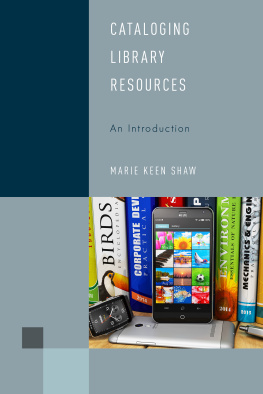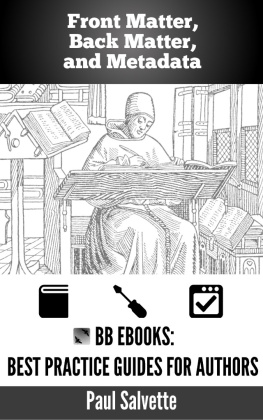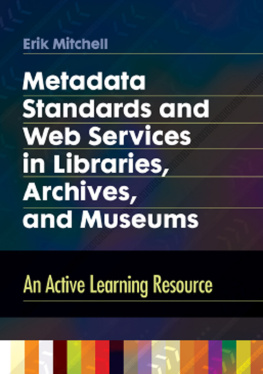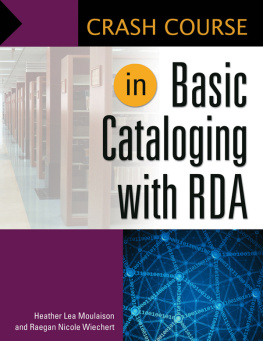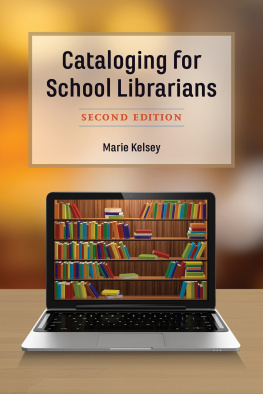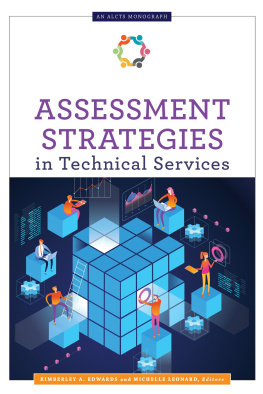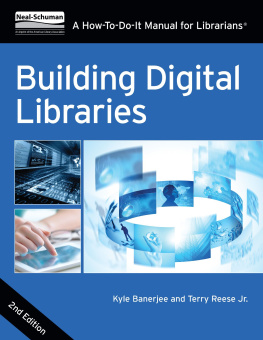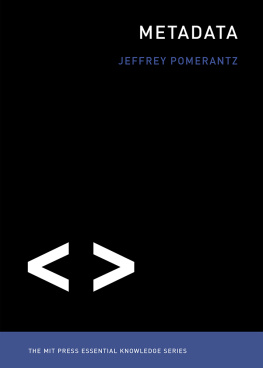XML for Catalogers and Metadata Librarians
Timothy W. Cole
Myung-Ja K. Han

Copyright 2013 by Timothy W. Cole and Myung-Ja K. Han
All rights reserved. No part of this publication may be reproduced, stored in a retrieval system, or transmitted, in any form or by any means, electronic, mechanical, photocopying, recording, or otherwise, except for the inclusion of brief quotations in a review, without prior permission in writing from the publisher.
Library of Congress Cataloging-in-Publication Data
Cole, Timothy W.
XML for catalogers and metadata librarians / Timothy W. Cole and Myung-Ja K. Han.
pages cm. (Third millennium cataloging)
Includes bibliographical references and index.
ISBN 9781598845198 (pbk.) ISBN 9781610692915 (ebook)
1. XML (Document markup language) 2. CatalogingData processing. 3. Metadata. I. Han, Myung-Ja K. II. Title.
Z678.93.X54C65 2013
006.74dc23 2013006978
ISBN: 9781598845198
EISBN: 9781610692915
17 16 15 14 13 1 2 3 4 5
This book is also available on the World Wide Web as an eBook.
Visit www.abc-clio.com for details.
Libraries Unlimited
An Imprint of ABC-CLIO, LLC
ABC-CLIO, LLC
130 Cremona Drive, P.O. Box 1911
Santa Barbara, California 93116-1911
This book is printed on acid-free paper 
Manufactured in the United States of America
Recent Titles in Libraries Unlimited Third Millennium Cataloging Series
Susan Lazinger and Sheila Intner, Series Editors
Using the Open Archives Initiative Protocol for Metadata Harvesting
Timothy W. Cole and Muriel Foulonneau
Subject Access to a Multilingual Museum Database: A Step-by-Step Approach to the Digitization Process
Allison Siffre Guedalia Kupietzky
Moving Image Cataloging: How to Create and How to Use a Moving Image Catalog
Martha M. Yee
Collection-Level Cataloging: Bound-With Books
Jain Fletcher
Practical Strategies for Cataloging Departments
Rebecca L. Lubas, Editor
Demystifying FRAD: Functional Requirements for Authority Data
Qiang Jin
FRSAD: Conceptual Modeling of Aboutness
Maja umer, Marcia Lei Zeng, and Athena Salaba
Demystifying Serials Cataloging: A Book of Examples
Fang Huang Gao, Heather Tennison, and Janet A. Weber
Contents
Preface
Libraries have long been early adopters of new technologies. By the late 1930s, well before the first programmable digital computer was built and more than 40 years before the introduction of the first desktop personal computers, libraries were using punch card systems (developed originally as tools for accountants) to streamline library circulation workflows. The Library of Congress acquired its first digital computer in 1964, at a point in time when such systems were still a relative rarity even on university campuses; two years later, the MAchine-Readable Cataloging (MARC) format was born (Arms 1990, 1417). The advent of MARC, still ubiquitous in libraries today, was truly a watershed moment for library cataloging and bibliographic control.
What initially drove many early experiments in library automation during the mid-twentieth century were the twin realities of disproportionately rising costs and the growing disjuncture between the strengths and capabilities of the traditional library and the changing information habits and demands of its clientele (Battin 1990, 2). These motivating forces still pertain today and still drive libraries to investigate and adopt new technologies. In addition, as librarians have continued to explore and develop computer-based technologies, they have come to appreciate that many of these technologies can facilitate interoperability and, in doing so, can enable a level of collaboration and shared cataloging work flow not feasible before. This added benefit has further encouraged experimentation with and early adoption of computer technologies in libraries.
Today, as catalogers and metadata librarians struggle to manage and describe ever increasing volumes of resources (both digital and print) from increasingly disparate and diverse sources using a growing number of distinct metadata standards and dialects, working knowledge of new and emerging technologies, such as the Extensible Markup Language (XML), are among the most commonly requested qualifications appearing in cataloger and metadata librarian job postings. XML is a useful and increasingly prevalent format for authoring and validating structured data. The use of XML in cataloging and metadata work flows helps enforce and ensure metadata quality, the consistency of cataloging work flows, and adherence to standards. The use of XML facilitates the reuse and repurposing of catalog and metadata records. XML and XML-related technologies can simplify cataloging and metadata work flows and can support more efficient batch creation and processing of metadata and catalog records. Needing to do more with less, library administrators look to leverage the efficiency and scalability that technologies like XML bring to traditional cataloging units and new digital library initiatives alike. This in turn mandates a workforce well versed in XML and XML-related technologies.
This book is aimed at helping current and would-be catalogers and metadata librarians progress beyond a bare surface-level acquaintance with XML. We assume that readers come to this book with some prior knowledge of descriptive cataloging traditions and/or descriptive metadata basics albeit not necessarily an extensive amount of knowledge on these topics. The catalog and metadata records used in our examples and case studies are drawn largely from library contexts, but they are basic enough to be recognizable to professionals and students working in other cultural heritage institutions, such as museums, archives, historical societies, or any of the myriad other entities and organizations charged with the curation of physical or digital information resources. We do not assume any prior knowledge of XML, though a level of comfort with generic computer applications, such as Web browsers and word processors, is helpful in order to fully follow and experiment with the illustrations provided. In order to get the most out of the examples and illustrations in this book, we encourage readers to install an XML editor of their choice on their work station (for suggestions, see the section Tools for Creating, Viewing, and Editing XML Metadata in ).
We have organized this book in four parts. that support the reuse and repurposing of XML and logical reasoning and inference across an aggregation of resource descriptions. Although a few of the details of these more sophisticated facets of XML may be advanced for some readers, we include these examples and case studies in order to illustrate the power of XML.
Throughout this book, we focus on examples of XML in action, introducing specific facets and features of XML and demonstrating how these features are exploited in practical contexts to support particular cataloging and metadata workflows. Within each part of this book, illustrations and case studies drawn from practice show how XML can play a pivotal role in meeting a concrete need. Many of the case studies introduced in the book are from our own work at the University of Illinois at Urbana-Champaign Library, but we also draw examples and case studies from other libraries and from collaborative projects, including the Academic Commons


